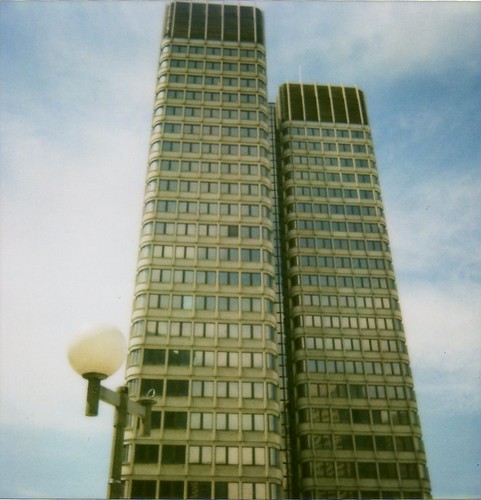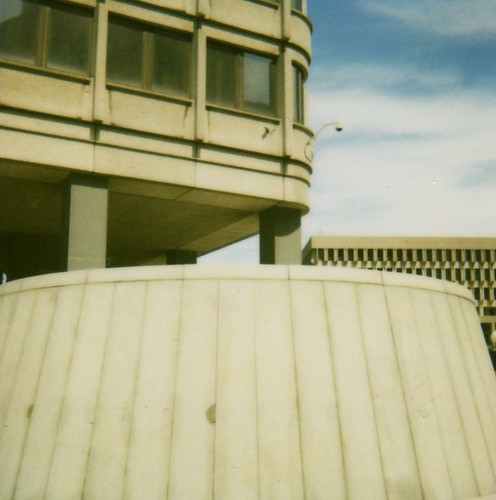
I recently finished Owen Hatherley's Militant Modernism which is basically a study in socialist-oriented 20th century modernism with specific respect to architecture. Given that Hatherley is an Englishman, I found the most well researched and interesting parts of the book to be about British public housing. Like myself, Hatherley recognizes that both classical modernism and high modernism contained progressive and utopian elements which recognized the positive potential in human beings to create new and advanced communities for themselves. As he succinctly defines it, modernism is a "movement aiming at transforming everyday life through art, or rather abolishing art by transforming everyday life." It suffices to say that to prefer these older forms to the yuppie garbage which pass for modern today will likely get one slagged off as a nostalgic, something Hatherley is certainly familiar with. This is one of the reasons the subtitle for this blog used to be 'thrift shop conservatism' but was changed due to a new emphasis on redefining an independent Left which seeks alliances with an independent and alternative Right to "confound the corporate center."
This being said, as a fan of his writing there are some things which I would like to see addressed with more clarity. While I found Hatherley's defense of Brutalism in British public housing admirable, summed up with the phrase "nothing is too good for ordinary people", given the history of public housing as well as other uses of Brutalist architecture (which I will soon get to) certain questions are raised which cannot afford to be critically avoided.

The first is a question about public housing itself. Hatherley, like so many detractors on the Right, seems to make little distinction between British midcentury social democracy and Soviet socialist republicanism (i.e. the Lenin years) as Militant Modernism jumps between these two very different socio-economic systems using the common denominator that both were leftist and employed modernist housing schemes. As such he seems either unaware or unwilling to address the role of the state in all of this. In other words, what the state giveth it can also taketh away. Of course Hatherley is certainly aware of this as it became a Thatcherite policy continued up to Brown to either demolish or condo-ize these relics of postwar social democracy. Now I certainly support affordable and utilitarian housing in the shape of modernist high rises for ordinary people. As someone braving the gratuitously overpriced Boston apartment market, a concrete high rise with a balcony and all mod cons (defined as heat, hot water and laundry) would be ideal for someone such as myself. It can be pretty bare bones as long as my books and clothes can all fit. Of course, the same policies have affected this country as well as the far fewer working class high rises this side of the pond have also been either demolished or yuppified. So the question remains as to the price of such social housing policies. Can we really rely on the state to consistently provide affordable and utilitarian housing for lower income folks if it will only sell it off to the highest bidder or simply destroy it when it becomes a budget burden?
Taking this a step further, I would also question the liberatory nature of such social housing. Hatherley uses examples which utilized then cutting edge architectural styles and provided such amenities as balconies and skywalks, as such these were certainly the cream of the crop when it came to public housing. He neglects to mention the much more common housing projects most people associate with social housing policies. Here in Boston, projects like Bromley Heath are neither modern or futuristic in any way. They are cesspools of crime and poverty where residents are met with security cameras outside their doorways and find their common areas patrolled by a projects-specific police force. They are little more than open air prisons with the residents representing a caste under state capitalism roughly equivalent to that of peasants under feudalism with the Boston city-state filling the role of the Medieval landlord.

This leads me to a questioning of the uses and ideology of Brutalism itself. While I am grateful for Hatherley's publicization of the aesthetically forward and socially populist aspects of Brutalism, I have yet to see him bring attention to its uses as the architecture of the intrusive state. As an example, I use the photos featured in this post of the John F. Kennedy Federal Building which now houses the Department of Homeland Security. While I personally appreciate the design and often enjoy sitting on the minimal, concrete benches in front before I have to go to work, the ideology inherent in the architecture which touts the power and omnipresence of the federal government cannot be ignored. For another example, I turn to this previous blog post featuring a rather Mussolini-esque moment for former HUD director Robert Clifton Weaver using a Brutalist backdrop to emphasize his point.
Going back to my first example, I will end with the lyrics of the Jonathan Richman song 'Government Center' (where the JFK federal building is located) which touches on the psychological aspects of working in that concrete palace of statist glory:
"Well we've got alot alot alot of hard work today
We gotta rock at the government center
Make the secretaries feel better
When they put those stamps on the letters"

No comments:
Post a Comment